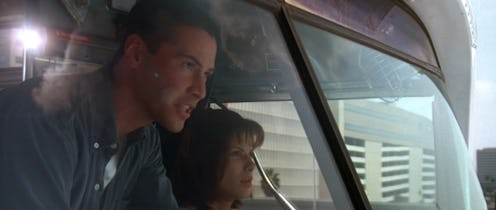Entertainment
Why 'Speed' Is The Blissfully Basic Thriller That's Going To Live Forever

Bustle's I'm So Jealous series is dedicated to the books, TV shows, movies, podcasts, and more that super fans are so jealous someone else gets to experience for the first time. In this installment, Sage Young writes about the thriller, Speed, which just turned 25.
I was 11 when Speed, starring Keanu Reeves and Sandra Bullock, was released in theaters in 1994. By the time it came to home video, I had worn my parents down and finally — finally — was allowed to see my first ever R-rated movie. Not that Speed is a particularly graphic R, in any sense — lots of stuff blows up and a few f-bombs are dropped, but there's zero nudity, a mere spattering of blood, and the cleanest, least upsetting decapitation you'll probably ever see onscreen.
And that, in conjunction with its minimal, streamlined premise, is what make the movie timeless and forever watchable. Made for a mere $28 million, Speed went on to pull in $350 million at the box office, internationally. (To put that low price tag into perspective, the Reese Witherspoon rom-com Sweet Home Alabama, in which nothing blows up, cost $10 million more to make.)
But back to the plot: There is a bomb on a Los Angeles city bus that will go off if the bus's speed drops below 50mph. That's not all that happens, of course. There are three major crisis situations in Speed, all orchestrated by the same domestic terrorist (though the movie never does refer to Dennis Hopper's character as such): first, a rigged elevator full of business people; then, the bus, which makes up most of the runtime and is generally the part people remember best; and one last showdown, on a subway train. But Speed includes no subplots. Its characters are only burdened with thinly sketched backstories. Nothing matters except the tension created by those scenarios.
What made this an easy watch for a preteen me was that the good guys are good in Speed. Reeves' LAPD officer Jack Traven is selfless, heroic, and looks great in a white t-shirt. Bullock's Annie is a civilian with a sarcastic streak who helps him save the day. And though there are the requisite romantic moments, she's neither sexualized by the film nor pursued by Jack until he's pretty sure they're safe. (He won't even stop calling her "ma'am" until she asks him to.) There's a reason why Bullock was dubbed "America's sweetheart" after playing this role, and that's because she seemed like someone you might know and really like.
And it's aged remarkably well, aside from a scene where Jack pulls a gun on a black, male driver so he can commandeer his sports car, which is played for laughs. Speed somehow does the most and isn't trying too hard at the very same time. Director Jan de Bont (Twister) and writer Graham Yost (who executive produced The Americans) never let off the gas much, throwing obstacle after obstacle in the way of our heroes. While it's not always realistic (Jack's final move, for example, had the potential to kill a lot of innocent Los Angelenos), many of the possibly deadly headaches they deal with actually are: traffic, a hysterical passenger, running out of gas.
There's a shocking amount of quotable dialogue for an action movie too, from the recurring "Pop quiz, hot shot" to Jack and his partner Harry's (Jack Daniels) exchange about the merits of sex versus another bodily function.
But when Keanu Reeves slides underneath a speeding bus on a sledge to try to dismantle the bomb, none of the above really matters. Just grab onto something and enjoy the blissfully uncomplicated ride.
If you're here for Keanu... Take note of the way Jack chews gum throughout the film, which, if you believe IMDB trivia, was an acting choice to show how the cool-on-the-outside officer sublimates his fear.
If you love it and want more of the same... Do not watch Speed 2: Cruise Control. Seriously, just don't.
Speed is even more enjoyable when you remember... That Bullock and Reeves recently confessed that they had secret, mutual crushes on each other during filming. Aw!
This article was originally published on